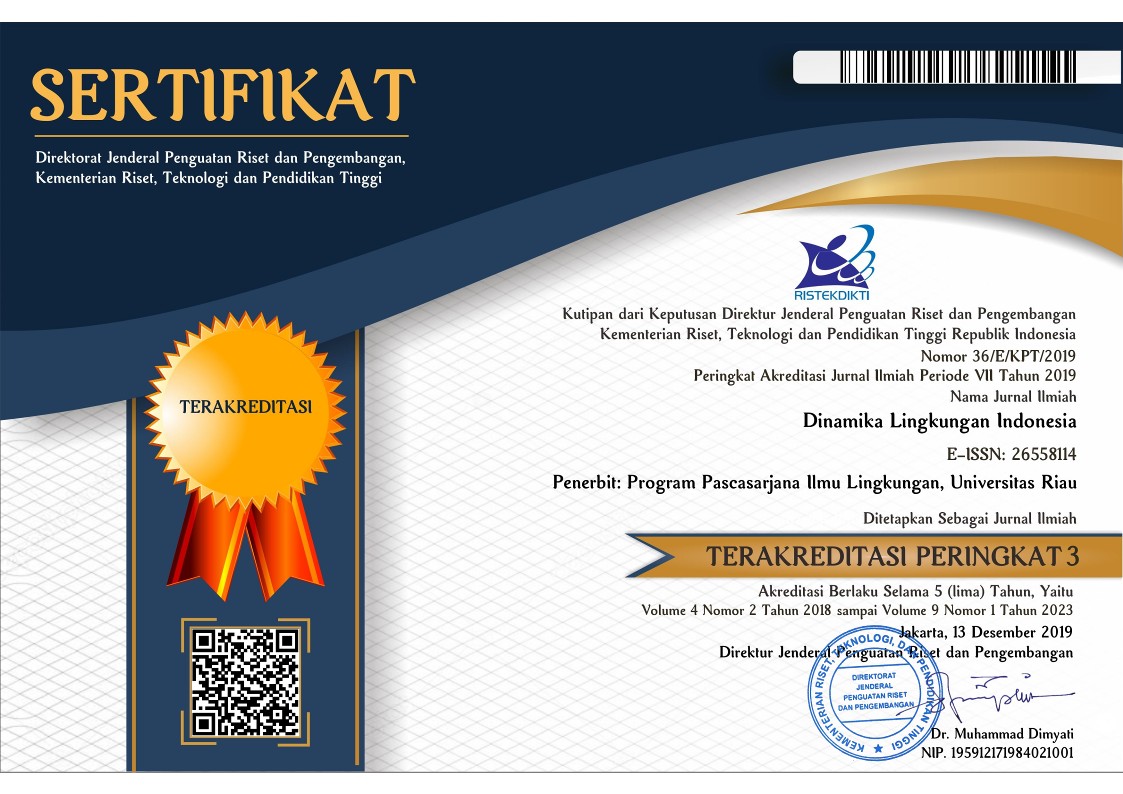Faktor-faktor Yang Mempengaruhi Keberadaan Jentik Aedes aegypti Terhadap Kejadian Demam Berdarah dengue (DBD) di Kecamatan Payung Sekaki Kota Pekanbaru
Abstract
The existence of larva an indicator of the spread of Dengue Hemorrhagic Fever (DHF) in a place that is measured with Density Figure of Larvae (DF). The increase in the number of dengue cases supported by the low of DF is influenced by several factors such as the physical environment, the behavior of governance of water reservoirs and population density. DF of Larvae in District Payung Sekaki in 2015 by 70%, which is still far below the national standard that is above 95%. This allows opportunities incidence of dengue and dengue virus transmission in these districts will remain high in the next year, especially in the five-year cycle of dengue. This study aimed to analyze the effect of directly and indirectly between the physical environment (rainfall, temperature, humidity, type of container and the presence of the container), the behavior of governance of water reservoirs and population density of the existence of larva, and analyze the effect of the presence of larvae of Aedes aegypti to incidence of dengue. Research conducted in April-December 2016 and located in four villages in Payung Sekaki District Pekanbaru City. Based on the research results, partially variables that affect the existence of larva is the presence of container with a direct influence positively of 10,843 times, the indirect effect 2,054 times and the total effect of 12,897 times, while the natural behavior governance of water reservoirs negatively have direct effects for 26,142 times, the indirect influence of 3,189 times and 29,331 times the total effect of the existence of Aedes aegypti larvae. Results showed no effect on the incidence of dengue larva presence in District Payung Sekaki with a P value (sig.) 0.278 (>α 0.05) but in spatial analysis there is an influence between the existence of larvae on the incidence of Dengue Hemorrhagic Fever.
Keywords
Full Text:
PDFReferences
Achmadi, U.F. 2013. Dasar-Dasar Penyakit Berbasis Lingkungan. Rajawali Press. Depok.
Achmadi UF, Sudjana P, Sukowati S. Demam Berdarah Dengue. 2010. Buletin Jendela Epidemiologi. Agustus 2010; Volume 2.
Brahim R, Hasnawati, Anggraeni ND dan Ismandari, F. 2010. Demam Berdarah Dengue di Indonesia Tahun 1968-2009. Buletin Jendela Epidemiologi. Vol. 2, Agustus 2010, hal: 1-14.
Burke. 2001. Under the Weather: Climate, Ecosystems and Infectious Disease Washington DC : National Research Counsil.
Depkes RI. 2003. Pencegahan dan Penanggulangan Penyakit Demam Dengue dan Demam Berdarah Dengue. Jakarta.
Depkes RI. 2005. Ekologi Vektor dan Beberapa Aspek Perilaku. Dirjen PPM dan PLP. Jakarta.
I N Gede Suyasa, N Adi Putra, dan I W Redi Aryanta,. 2006. Hubungan Faktor Lingkungan dan Perilaku Masyarakat dengan Keberadaan Vektor Demam Berdarah Dengue (DBD) di Wilayah Kerja Puskesmas I Denpasar Selatan. http://www.akademik. unsri. ac.id/download/ journal/files/udejournal/suyasa_pdf.pdf diakses 26 Desember 2016.
Kantachuvessiri, A., 2002, Dengue Haemorrahagic Fever in Thai Society, The Southeast Asian Journal of Tropical Medicine and Public Health, Vol 33 No.1, Maret 2002. p4-10.
Michael. 2003. Climate Change and Human Health Risk and Responses. WHO: Geneva.
Notoatmodjo S. 2010. Promosi Kesehatan dan Ilmu Perilaku. Rineka Cipta. Jakarta.
Soegijanto, S. 2008. Demam Berdarah Dengue, Edisi 2. Airlangga University Press. Surabaya.
Sunarto. 2015. Analisis Faktor-faktor yang Berhubungan dengan Keberadaan Jentik Nyamuk Aedes aegypti di Kecamatan Magelang Utara Kota Magelang. Diakses melalui http://www.google.com tanggal 30 Desember 2016.
Tahir, MA., Hiola, R., Pateda, SM. 2013. Hubungan Kepadatan Jentik Aedes aegypti dengan Kejadian Penyakit Demam Berdarah Dengue (DBD) di Wilayah Puskesmas Telaga Biru Kabupaten Gorontalo. Artikel. Universitas Negeri Gorontalo.
Widagdo, L. 2008. Kepadatan Jentik Aedes Aegypti sebagai Indikator Keberhasilan Pemberantasan Sarang Nyamuk (3M Plus) di Kelurahan Srondol Wetan, Semarang. Diakses dari http://journal.ui.ac.id/upload/artikel/03_Laksmono_kepadatan_jentik_ Layout.pdf tanggal 25 Desember 2016.
World Health Organization. 2001. Panduan lengkap Pencegahan & Pengendalian Dengue & DBD (Alih bahasa : Palupi Widyastuti), Regional Office for South East Asia Region,World Health Organization, New Delhi.
DOI: http://dx.doi.org/10.31258/dli.4.1.p.59-64
Refbacks
- There are currently no refbacks.





